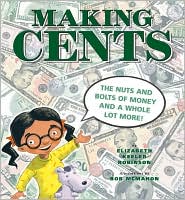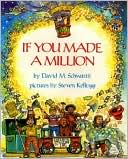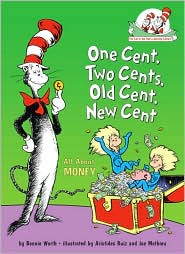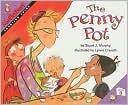These resources will help you to teach money to 2nd graders, utilizing great on-line interactive websites, lesson plans, and a variety of books. Money is an essential concept for children to learn and for them to be able to recognize how combining different denominations of coins can equal each other.
In regards to money, there are a lot of great books that teach the concept and incorporate how money is made, allowance, what you can buy with money, and how different coins added together equal others. I found these books to be the most useful for the classroom:
 Making Cents– By Elizabeth Keeler Robinson, illustrated by Bob McMahon
Making Cents– By Elizabeth Keeler Robinson, illustrated by Bob McMahon
This book is a story about children trying to save up to build a clubhouse and along the way they earn money in a variety of ways. It not only incorporates great pictures of coins and dollar bills, but it also tells who is on the face of each dollar bill. The book explains what you can buy with each coin denomination and dollar bills as well as visually showing children how many different ways you can make certain amounts, such as $1.00.
 If You Made a Million – By David M. Schwartz, illustrated by Steven Kellogg
If You Made a Million – By David M. Schwartz, illustrated by Steven Kellogg
This book is a great visual representation of money equilvalencies and can really get children to understand how there are many ways to make $1.00 such as 100 pennies,20 nickels, 10 dimes, 4 quarters, or 1 dollar bill. It explains what you can buy with each amount as you earn it throughout the book and goes all the way up to 1 million. The concept of putting money in the bank to gain interest is also explored.
 The Coin Counting Book– By Rozanne Lanczak Williams
The Coin Counting Book– By Rozanne Lanczak Williams
This is a rhyming book on money and talks about trading coins for other coins. It explains coin equilvalencies and each money value is represented in words, pictures, and numbers. The book uses grouping to count the coins and also works a little on counting by tens in pennies to get to $1.00.
 One Cent, Two Cents, Old Cent, New Cent: All About Money – by Bonnie Worth, illustrated by Aristides Ruiz and Joe Mathieu
One Cent, Two Cents, Old Cent, New Cent: All About Money – by Bonnie Worth, illustrated by Aristides Ruiz and Joe Mathieu
This is a great Dr. Seuss rhyming book that starts with where money came from and how it was used in ancient times in bartering. The story goes on to how coins were gradually made by metal and how coins were different in different countries. It talks about United States currency and shows pictures some of the coins and of each of the dollar bills and whose face is on them.
 The Penny Pot– By Stuart J. Murphy, illustrated by Lynne Cravath
The Penny Pot– By Stuart J. Murphy, illustrated by Lynne Cravath
This story begins at a school fair and one little girl, Jessie, really wanted to get her face painted and didn’t have 50 cents to do so. Throughout the book other kids come to the table to get their face painted and the book shows each coin they put in the jar. When they have more than 50 cents, they put the change in the penny pot. At the end of the story, with Jessie’s money and the money in the penny pot she finally has enough money to get her face painted, with a few pennies left over. This book shows different ways to get 50 cents and uses numbers and visual representations of counts to count.
Web Sites
I found a lot of great websites for kids to learn about money and explore the concept of counting. My five favorites are below.
Hands on Banking: This website is made by Wells Fargo Bank and through the help of an alien, walks kids through what money is, how you make it, and what banks do. It talks about buying items as well.
Toon University: This website gives kids a numeric money value at the top of the page and has coins at the bottom of the page. Kids drag coins into the cup to get to the appropriate amount. This gives kids a great opportunity to explore the easiest way to get to a larger amount instead of using smaller coins.
Superkidz: This website allows kids to pick which person they want to shop with at the store. For each problem, there are 3 items shown with the amount they cost. Kids figure out the problem by subtracting the amount of the item they bought from their initial amount. It not only gives kids a great way to practice counting money based on the picture of the coin, but it gives them great subtraction practice.
Cash Out: This is a great interactive game for kids to play and they are the cashier. They help customers make purchases and the customer tells them the amount of the item, how much they are paying with, and the change they need back. The kids choose the correct coins to give the right amount of change back to the customer.
Memory Game: This game is on the governments website and it allows kids to correctly match coins by front and back. It is just like a regular memory game but with coins.
Additional Resources
Printable Money– These are great visual models of real coins that can be printed and used as manipulatives in the classroom.
Berenstain Bears Lesson Plan – This lesson plan not only incorporates money and savings, but it is also a good lesson on economics for students using the book, “The Berstain Bears Trouble with Money.”
Changing Face of Money – This lesson plan gives children the opportunity to evaluate what they think has been used as a form of money and what has not. It explains how the face of money has changed a lot over time and in the end they should be able to describe a few changes that have taken place over the years with money.
US Mint for Teachers – This government website gives teachers tons of resources to use in the classroom to teach money. It has lesson plans, financial literacy, book lists, helpful websites, a glossary, and lots more.
MegaPenny Project – This website is a great visualization for kids to see actually how much one thousand, one million, and up to one trillion pennies looks like. It gives kids a chance to see how much a big number is but it starts out with smaller amounts.
